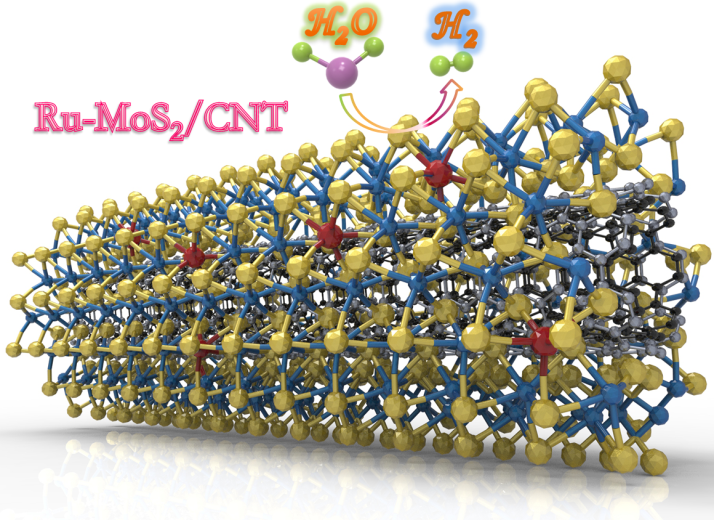Hydrogen production by water electrolysis is an important energy technology for achieving a sustainable hydrogen economy. The development of inexpensive, high-performance hydrogen evolution and oxygen evolution catalysts is the basis for the large-scale application of electrolysis water systems.
In a study published in Adv. Sci., Prof. WANG Ruihu from Fujian Institute of Research on the Structure of Matter(FJIRSM) of Chinese Academy of Sciences and Prof. LIANG Yongye from Southern University of Science and Technology, cooperatively reported a core/shell structured hybrid catalyst, which features few-layered ruthenium(Ru)-doped molybdenum disulfide (MoS2) nanosheets closely sheathing around multiwalled carbon nanotube (CNT), for highly efficient hydrogen evolution reaction (HER).
By transmission electron microscopy (TEM) and X-ray diffraction (XRD), researchers investigated the detailed structural features of representative Ru-MoS2/CNT with Ru doping amount of 5 at% (atomic percent). High-resolution TEM images show that few-layered 2H-MoS2 nanosheets epitaxially sheath around the CNT core.
By virture of energy dispersive X-ray spectroscopy (EDS) mapping, they confirmed the uniform distribution of Ru element in the Ru-MoS2 shell. Theoretical calculation results demonstrated that Ru atoms could be stably doped into 2H-MoS2 by substituting Mo atoms and coordinating to six S atoms.
Besides, researchers performed X-ray photoelectron spectroscopy (XPS) analyses to study the electronic effects on Ru-MoS2/CNT induced by Ru-doping. The results not only indicated that the chemical states of Ru atoms in Ru-MoS2/CNT are significantly different from those in RuS2/CNT but also provided a strong evidence that Ru atoms are stably doped into MoS2 lattice.
By density functional theory (DFT) calculations, researchrers revealed that Ru-dopant in MoS2 effectively modulates the electronic properties of the adjacent in-plane S atoms, which represent new active centers for facilitating water adsorption, dissociation, and hydrogen adsorption/desorption.
This study opens up new opportunities in exploring cost-effective electrocatalysts based on transition metal dichalcogenides for practical applications.

Simplified schematic illustration of Ru-MoS2/CNT microstructure. (Image by Prof. WANG’s group)
Contact:
Prof. WANG Ruihu
Fujian Institute of Research on the Structure of Matter
Chinese Academy of Sciences
E-mail: ruihu@fjirsm.ac.cn